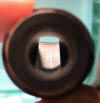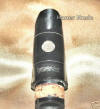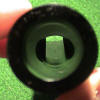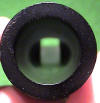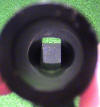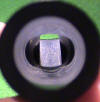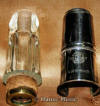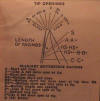Read the Otto Link mouthpiece Reviews here, various posts:
The Woodwind Forum
1st Generation – This model HS* is identified by the old Selmer
oval emblem. The emblem is located just above the tenon. The HS* can be seen at
the very bottom of the table. The Throat is a A variety which allows not
only centered but a nice spread tone, very flexible. Approximate age: before
1926
‘Air-Flow’ era 2nd generation
(pre 1938) Considered a “Special Edition” mouthpiece due to a
limited production run this Selmer mouthpiece lasted a few years in conjunction
with the Selmer saxophone Air-Flow models. This model started the “table”
markings. This model had the normal “table
HS**” stamp but above it it also had “precision garantie”. between the
lower ligature lines and the tenon were the words “H. Selmer” in script.
Probably in the same early 1930s era
as the Selmer-Johnston. Photos courtesy of Barb Tucker from Hauer Music
2.5 Generation – Model 36 – Johnston-Selmer – New York – I’m
not sure where to put this as it is a Selmer USA model released with the
advertising of Mr. Johnston who was touting the Selmer SBA saxophones at the
time. I assume it was made around 1936 in conjunction with the lower
emblem Selmer Paris mouthpieces. I cannot find a “france”
stamp anywhere but it may simply be a Paris model. Marked HS* at the base of the
table just like the 1st Gen Paris model
3rd Generation – Identified by the new Selmer logo on the lower
part of the body. Throat the same A type frame. The word “table HS*” is
imprinted on the table. To the right of the table is the Brand measuring
system, which Selmer adopted used since July 1, 1938 on all Selmer and Selmer
sponsored mouthpieces. This numbering system allows you to understand the
exact measurements of the original facing. The first two numbers
representing the length of the lay in 1/2 mm, and the second last 3 digits the
tip opening in hundredths of a mm
Pre 1938 – without the Brand measuring system, lower emblem
Post 1938 – with the Brand measuring system, lower emblem
4th Generation – Logo moved to the middle of the body, though
still high in comparison to modern Selmer mpcs. The “Table HS” is now
inside of and oval on the table. Throat has much more vertical sidewalls
than previous versions, but the walls are still wide apart in comparison to
other makes. These mouthpieces were apparently provided with the Centered
Tone clarinets and through the 1960s
5th Generation – Selmer emblem still high up the body but now
the HS* identification is on the front just under the 2nd ligature line. There
were apparently sold with the the 1960s and later
6th Generation – Selmer emblem and HS** is slightly lower,
though not in the middle as the later models. This is a HS** (larger tip
than the HS*). The location of the HS and emblem may be a quirk with just
the HS** – more mpc sighting have to be recorded.
6th Generation – Selmer emblem moved to the middle between the
ligature lines. HS* moved more downwards from the 2nd ligature line. The
HS* font is now larger than previous generations
Selmer Crystal Clarion
Selmer Crystal (1980ish)
Photos courtesy of Barb Tucker from Hauer Music. Though this is a
Selmer crystal, most of the Selmer crystal mouthpieces were manufactured by
O’Brien. This on in particular looks exactly like the O’Briens from the
late 1970’s and early 1980s, including the brass tenon cap.
Selmer – later model
This is a beautiful sounding O’Brien (Selmer). I thought my 1980 model
sounded good. This Selmer Obrien (in with an old metal clarinet) sounds
absolutely beautiful – rivaling my 1920s mouthpieces. This model is longer
than the normal Obrien with internal variations that give it a warmer and more
centered tonal quality. Response is extraordinary across the range from
low E to altissimmo.
Later Selmer Crystals
Selmer Crystals were also made by Pomarico at one time. They had a specific
designation “201” Crystal. These were marketed in the mid 1990s as Selmer
“New Crystal” and had facings of #1,2,3,4,5. later 4 & 5 were dropped.
These are identifiable on the tables as they had “Italy” etched on them
| model designation (ie, B, HS*) | tip opening in mm |
| A | /17.5mm |
| A* | /16.5mm |
| HS | /18mm |
| B | |
| B* | 1.05/18mm |
| C | 1.05/19mm |
| C* | 1.10/19mm |
| C** | 1.15/19mm |
| D | 1.20/18mm |
| E | 1.30/18mm |
| F | 1.40/18mm |
| G | 1.50/18mm |
| H | 0.92/18mm |
| HS* | 1.00/18mm |
| HS** | 1.20/18mm |
| S | /17 |
| C85-105 | 1.05/19mm |
| C85-115 | 1.15/19mm |
| C85-120 | 1.20/19mm |
| CP100-118 | 1.18/27 |
| CP100-122 | 1.22/27 |
| CP100-125 | 1.15/27 |
(from the Selmer Catalog)
THE STANDARD SERIES
(HARD RUBBER).
The world over, professionals as well as students use mouthpieces from this
popular series. Every player can find a suitable set up from the extensive range
of tip openings and facing lengths. Standard Series mouthpieces are available
for the complete clarinet family, from E soprano to BB contrabass clarinet.
Standard facings – B*,
HS*, HS**. (and other sizes)
200 – Eb Soprano Clarinet
201 – Bb Clarinet
202 – Alto Clarinet
203 – Bass Clarinet
204 – EEb Contra-alto Clarinet
205 – BBb Contrabass Clarinet
THE C85 SERIES
(HARD RUBBER). Selmer (Paris) C85 mouthpieces bring a new sound to clarinets
– a large sound, rich in low overtones, with a subtle blending of power and
roundness. C85 mouthpieces are available for E soprano, B , and bass
clarinets. Standard facing – 115. 105 & 125
220 – Eb Soprano Clarinet
221 – Bb Clarinet
223 – Bass Clarinet
CP 100 B b CLARINET
MOUTHPIECE
The CP 100 mouthpiece widens the B b clarinet mouthpiece range made by Selmer
(Paris). The CP 100 is a very flexible mouthpiece adapting to various playing
situations (from solo work to playing in the Orchestra clarinet section as
well). It is an easy blowing, controllable, full tone mouthpiece with an
excellent tuning balance all over the scale. An interesting professional
mouthpiece. The CP 100 mouthpiece is now available for B b soprano clarinet; it
is offered in three different versions (118, 122 and 125), see chart.
CP211 – B b Clarinet
1931 Tip Opening Chart



